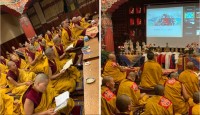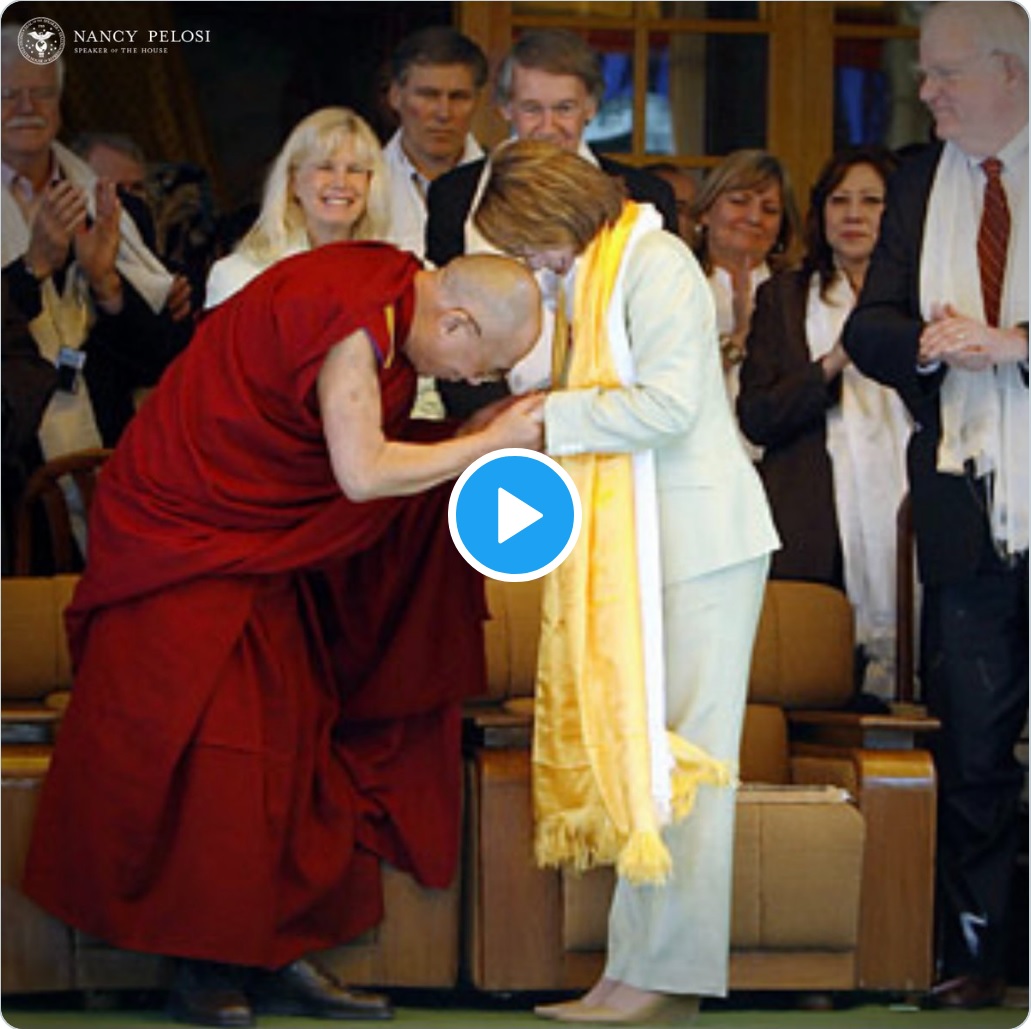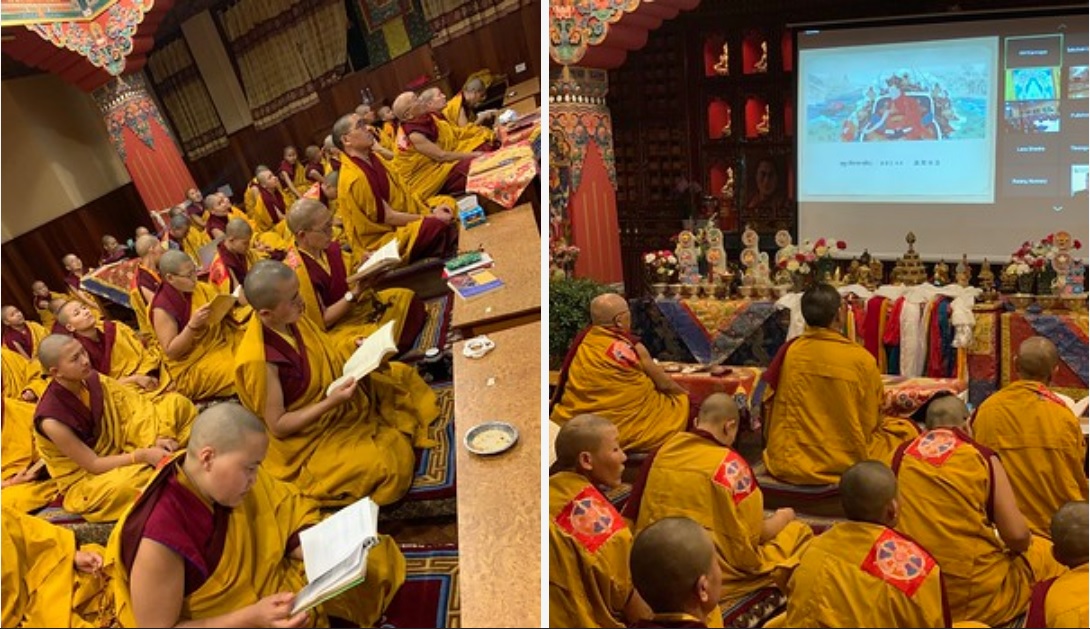法王新闻 | 2021年02月
『第6届谶摩春季』噶玛巴米觉多杰自传•第10天第1堂課
『6th Arya Kshema』AUTOBIOGRAPHICAL VERSES OF KARMAPA MIKYÖ DORJE•10-1
༸རྗེ་བརྒྱད་པ་མི་བསྐྱོད་ཞབས་ཀྱི་རྣམ་ཐར་བཀའ་ཁྲིད། བདེ་བྱེད་མའི་དཔྱིད་ཆོས་ཉིན་བཅུ་པ།

時間:2021年2月27日晚上9:00-10:00(北京/台北/香港)February 27, 2021
中文口译:堪布丹杰
听打:释妙竹
English text source from: Arya Kshema website
德新谢巴此行对中国汉地的影响
Part 1: Deshin Shekpa Travels to China
首先要问候大家扎西德勒,开始课程前,大部分僧众都是在印度、尼泊尔。主要是疫情要很好地多注意、多预防,听说在印度、尼泊尔,大家有时会比较轻忽这个疫情,所以我有时也比较担心各位的情况,希望僧众们你们能够尽量地照顾好自己,疫情要多注意,做好防疫。昨天我的摄影机不听话,只好结束课程了。今天要把昨天的部分接续讲完。
The Karmapa began with advice for those in India and Nepal not to become too relaxed about the Covid 19 pandemic but to continue to be very careful and take precautions.
永乐皇帝迎请德新谢巴的醉翁之意
在赞普时代结束之后,吐蕃就分裂了。在唐朝的时候,在中国很多的历史文献中,会称西藏叫吐蕃。这个是བོད་的音译,在敦煌的一些文献当中,就有一个汉藏对照的文字,里面就很清楚地这样记载。在宋、明之后就比较少用吐蕃的名称,而多是称西藏为乌斯藏或卫藏,永乐皇帝当时就是从乌斯藏迎请德新谢巴,当时文献就是这么写的。总之德新谢巴也到了中国,也为永乐皇帝的父母举办了广大的超荐,尤其中国话当中很注重对于父母的孝顺的礼数,所以圆满了尽孝道这样一件事。不仅如此,永乐皇帝还跟德新谢巴就西藏的治理做了更多的讨论。这部分昨天稍微有提到,总之,最开始永乐皇帝的想法是德新谢巴能够像元朝八思巴尊者一样,能够承担起西藏政治上治理的责任,事实上元朝皇帝忽必烈就册封八思巴为大宝法王,之后永乐皇帝又稍微在前面加了些像如来,给德新谢巴如来大宝法王的称号。
According to the histories, the Ming emperor Yongle invited the Fifth Karmapa, Deshin Shekpa, from Ütsang [which is how the Chinese documents refer to Tibet] to perform rituals for the emperor’s deceased parents, a custom which is very important in Chinese culture. During the Karmapa’s visit, the emperor also had lengthy discussions with him on political strategies he should adopt in Tibet. The emperor hoped that, with his military backing, Deshin Shekpa would assume political power and responsibility in Tibet, in the same way that Drogön Chögyal Pakpa had done during the Mongol Yuan dynasty. Kublai Khan had given Drogön Chögyal Pakpa the title “Precious King of Dharma” and the Ming Emperor now gave that same rank and title, with just some minor differences, to Deshin Shekpa
这个称号可以看出永乐皇帝就希望德新谢巴像元朝八思巴尊者一样。但是第五世噶玛巴德新谢巴对于政治的责任是并没有任何兴趣的,甚至还跟永乐皇帝说:元朝还出兵攻打西藏,如果你们也出兵攻打西藏的话,会造成藏族人民很大的痛苦。同时德新谢巴还提到:西藏佛教有不同的派别,这是很好的,因为能够满足人们各自不同的需求。甚至他还希望永乐皇帝能够册封其他教派的宗教领袖,各地区的首领,给予他们地位和封号。德新谢巴回到西藏后,永乐皇帝也真的给予这些封号了。当时,明朝也迎请宗客巴大师到中国,但他没有办法去,所以就派了代表(Bamboo:宗客巴大师也不想鸟这个到处招佛门傀儡的土皇帝)。总之皇帝就册封了格鲁派的领袖叫大慈法王,萨迦派的领袖叫大乘法王等等。永乐皇帝之后的历代明朝皇帝也都有给予西藏各个领袖封号的传统,可以说这都是德新谢巴对于皇帝建议的影响,说这是德新谢巴的恩德也是不为过的。
Deshin Shekpa had no wish to accept any political power or responsibility and gave two reasons: sending a Chinese army into Tibet would only create turmoil and strife for the Tibetan people; and having many Dharma lineages in Tibet was beneficial. He requested instead that the Ming emperor give positions and titles to both secular and religious leaders of all traditions in Tibet. This the emperor did, and the Ming dynasty continued this tradition. After Deshin Shekpa returned to Tibet, the Ming emperor invited Je Tsongkhapa. Tsongkhapa, however, was unable to go, but the emperor likewise invited Jamchen Chöje of the Geluk order, Tekchen Chöje of the Sakya and so forth, giving them titles, just as he had given Deshin Shekpa.
各教派大师们对德新谢巴的感激和称赞
还有永乐皇帝也在德新谢巴的建议下,多次大赦天下,德新谢巴对于众生的关爱是非常的广大,实际做到了很多这样的行为。德新谢巴的前世就是噶玛巴若佩多杰,圆寂前做了一个授记,说:在这个山上的一个比丘圆寂之后,如果能将他的身体火化,那么他在来世,明朝就不会有派兵的危险。还有根敦岗巴的一个大堪布叫索囊桑波,他也对于德新谢巴写了一个赞文,对德新谢巴礼敬,大意是说:“若佩多杰的转世德新谢巴,他利益无量的众生,帮助众生从恐惧中出离,成就广大的善行,这一位就是德新谢巴。”所以你看到不是冈仓噶举的上师所写,而是由根敦岗巴这位大堪布所写的赞文。
While Deshin Shekpa was in Nanjing, he made many suggestions to the emperor, and consequently, the emperor granted amnesties to people in prison. This is evidence of Deshin Shekpa’s great loving-kindness towards sentient beings, which he showed in his acts many times. He also fulfilled a prediction made by the Fourth Karmapa, Rolpai Dorje. This said that if a pure bhikshu were to pass away on a certain mountain and his body were to be cremated, there, there would not be war between China and India. Eventually, Deshin Shekpa passed away on that very same mountain and his body was cremated there; because of which his successor was able to go to India and prevent the war between China and India. The Khenpo of Gendun Khang composed a praise which said that the incarnation of Rolpai Dorje would be able to protect many sentient beings from danger and bring them happiness. Knowing this, he would take rebirth intentionally - that was Deshin Shekpa.
由于以上这些原因,德新谢巴在中国有很大的佛行事业之后,回到了西藏,也受到藏地很多大师的邀请,前往他们的寺院。当时三界的法王,也就是宗客巴大师也致信给德新谢巴,这封信在宗客巴大师的教言集中有收录,信很长,这里我节录几句:释迦教法的弘扬没有比你更承担起这样一个人了,也不需要我再向您祈请,而是您就这样地做到了广弘佛教。随着给德新谢巴的这封信,还供上了热振寺的一个所依——一尊坐姿像弥勒菩萨的释迦佛像给德新谢巴。之后第十六法王从西藏带到了隆德寺,也放在了隆德寺的宝库当中。(Bamboo:查查看,还在不在了。)
On his return to Tibet, many people came to welcome him. Even Je Tsongkhapa sent him a letter, which is preserved in the Collected Short Works of Je Tsongkhapa. In this letter it says: “Regarding the person who takes responsibility for the teachings of the Buddha to flourish, there is no one greater than Deshin Shekpa, the Karmapa”. Along with the letter, he sent a statue of Buddha Shakyamuni sitting in the seated position of Maitreya from Reting monastery. The Sixteenth Karmapa brought the statue with him from Tibet and it is in the treasury at Rumtek Monastery in Sikkim. Masters from other traditions also wrote letters.
之后还有萨迦派的一位大师龙顿谢恰给瑞,他也在信中提到过“在这么多的善知识和大师当中,德新谢巴真的就如佛降临一般”(Bamboo:这也未免太夸张了,又不是伊斯兰教徒,作为佛教徒这应该是最基本的吧),巴沃祖拉陈瓦有看过这样的信件,还有德新谢巴的亲传弟子—楚布的蒋央千波撰写的一个法王传记当中有记载。德新谢巴住在南京的时候,不仅仅皇帝、皇亲国戚这些贵族,还有非常多的老百姓,像是汉族等说不同语言的老百姓去谒见法王。而且法王在说法的时候,他的前后左右还安排有四、五位的译师翻译,还有很多前往谒见法王的民众当中,许多是从很远的地方三步一拜地来谒见法王的。当时法王就告诉他们,要怎么修行呢?就告诉他们要多加行善,像是持诵佛菩萨的名号,也要他们发愿断除杀生等等(Bamboo:自个吃的那些羊是怎么死的?现在诈骗集团都会这么说)。在这部传记中有提到。
Tsurphu Jamyang Chenpo, a direct disciple of Deshin Shekpa, wrote a namthar which was unavailable before but which we do have now. In it, he states that during the time that Deshin Shekpa was in China, it was not only the high officials who came for an audience, but many people came who spoke various different languages. Thus, Deshin Shekpa would teach the Dharma surrounded by four or five translators. Many of the people who came for audience with Deshin Shekpa had travelled for days, prostrating with each step they took, as was the old Chinese tradition. Mainly, Deshin Shekpa taught reciting the name mantras of the buddhas and bodhisattvas and making commitments, such as giving up killing. Thus, he encouraged the people to practice virtue.
佛教就是这么被参杂、篡改的

这里我想附带提到一个,就是现在在中国的国家图书馆,珍藏了一部明代汉藏佛教版画艺术相互交流很重要的一个刻本,叫《诸佛菩萨妙相名号经咒》。后来他们有复印,给你们看一下。就是这一部。这部书的文字以汉文为主,还加上了现在尼泊尔用的蓝杂体的梵文、藏文和蒙文,四种文字写成的,头尾还有几篇汉文的篇章,主要的内容就是结合汉藏风格的佛菩萨的版画、名号和咒语这三部分组成。当中也有德新谢巴的一个画像,就是投影看到的德新谢巴的版画。这本书印刷于明宣德六年,1431年,出资刊印的是德新谢巴的一个汉族弟子,叫修机善住,在北京印刷的。(Bamboo批:日本人的名字吧!)
In the Chinese National Library’s collection, there is a text called The Names, Images and Name Mantras of the Buddhas and Bodhisattvas. It concerns the exchange between China and Tibet of Buddhist texts and printing techniques during the Ming period. [ His Holiness showed a slide of the book which has been published using these texts]. The text is primarily written in Chinese; there are some sections that include four alphabets including Lentsa, Tibetan, and Mongolian with Chinese introductions and conclusions. There are three sections that are primarily sections that give the images, names, and name mantras of buddhas and bodhisattvas in a mixture of Chinese and Tibetan. There is an image of Deshin Shekpa among them. It was printed in Beijing in 1431, the sixth year of the reign of Emperor Xuande, by Deshin Shekpa’s Chinese student Xiūjī shànzhu.
这本书的前言有汉文也有藏文,藏文中提到的一些内容是汉文没有的,譬如说里面有一句话:右,刻印,西来大宝法王所传诸佛菩萨之相的佛经和经咒,并广为散施,以利益一切有情众生。总之,在这本书当中,很多佛菩萨的版画是结合了汉藏的风格而绘制的,对于藏传佛教是如何传到东方,是很重要的研究珍本。
The foreword to this text, in Chinese and Tibetan, reads, “The Karmapa or Precious King of Dharma has shared many of the Dharmas and scriptures that he had given. So, these are now printed in this book.” Many researchers say this is an important text and is a good source regarding how Tibetan Buddhism spread to the East into the Chinese areas.
同样,还有另外一个历史的文献和这本书一样的重要,也是明朝的一本书,叫《四有斋丛书》,里面提到一段,大意是:德新谢巴在灵谷寺举办大法会,当时示现了很多的瑞相,譬如很多人在天空中可以听到各种梵呗、音乐,胡广等大学士就去上表,写了一个歌颂,叫《圣孝瑞应歌颂》。法会之后,皇帝也对于德新谢巴和佛法更加地相信(Bamboo:才见鬼),就更加虔心地学习各种的佛经论典,而且把很多的经典编为佛曲,在宫中歌舞唱诵,在永乐的十七年,御制佛曲大部分完成了,就刊印,传给大众。
There is a similar text from the Ming dynasty called Sì Yǒu Zhāi Cóngshū which has the same meaning and the same influence as this text. The focus of this second text is Deshin Shekpa’s ceremonies for the emperor’s parents at the Linggu temple; there were different auspicious signs, divine music from the sky, and everyone saw and heard them. The witnesses reported what they had seen to the emperor, and the event was captured in a song entitled Auspicious Omens in the Sky. From that time on, the emperor’s faith in Deshin Shekpa became stronger and he studied the Buddhist scriptures even more assiduously than he had before. He also wrote Dharma melodies which were performed in song and dance in the palace. The emperor finished composing in the seventeenth year of his reign and printed everything in a book with some pictures of the Buddha. The book was distributed widely.
9月12日,他把这个佛曲配合佛经在大报恩寺公开,同时在淮安这个地方,这个佛曲也广传了出去。隔年,5月16日,命礼部尚书——吕政和另外一位官员王章机到陕西和河南去传扬他编的这个佛曲。可以看出这个永乐皇帝对佛法非常的有信心(Bamboo:司马昭也对曹操的子孙非常的有信心),就连他的王妃也对佛法非常的相信和恭敬,所以,他们就在南京城内外建立了非常多的梵刹(寺院)。看到这一段历史,和投影出来的这些书籍,看得出来这是很重要的一部典籍。(Bamboo:听得都快睡着了,啰里啰唆地重复昨天的东西,老娘打字打得要累死了。)
Then, on the 12th day of the 9th month, the emperor went to Dabaung monastery [which translates as” The Great Monastery of Repaying Kindness”]. He had the book reprinted and distributed. In the next year, on the 16th day of the 5th month, he asked for the two ministers to print and spread these texts with the names of the buddhas and bodhisattvas and melodies in the Shanxi and Henan regions. And so, the emperor’s mind moved into the direction of the Dharma. He had such a great interest in the Dharma; his queens also developed great respect for the buddhas and bodhisattvas. For the sake of all the people who had great faith in the Dharma, he built many monasteries inside and outside Nanjing and it was filled with temples.
六字大明咒在汉地的传扬
永乐皇帝就把这部《诸佛菩萨妙相名号经咒》编上了佛曲,广为散施。这里面有提到说一个佛曲,藏文叫法音,记得之前有提到过噶玛巴希到各地的时候都会举办顶戴黑宝冠的仪式,让大众唱诵六字大明咒,在很多历史文献中有这样记载。所以从第二世噶玛巴希开始,一直到历代噶玛巴,都持续着这个传统——在举办黑宝冠仪式的时候会唱诵六字大明咒。但是到了第十六世噶玛巴的时候,只会吹奏唢呐等乐器,就没有唱六字大明咒这样的传统。《四有斋丛书》有提到御制佛曲,我觉得这可能是和第二世噶玛巴传承下来的六字大明咒的乐曲唱调可能是有关系的。总之,当时很多人就对德新谢巴到南京后示现的各种瑞相也好,这些事情非常的有信心。尤其在举办超荐大普渡法会上会示现这么多的瑞相,很多老百姓对他升起了信心,所以当时很多汉族老百姓就开始每天没日没夜地念六字大明咒——嗡嘛尼呗美吽(Bamboo:什么事情过度了都是不好的)。
His Holiness briefly explained what is meant by Dharma melodies. Karma Pakshi, wherever he went, would wear the black crown, and recite the mani mantra to a melody, and spread that practice. The later Karmapas continued this form of activity, wearing the black crown and reciting the melodies. During the time of the 16thKarmapa, however, when he wore the black crown, they would play the gyalings but not recite the melodies. Thus, at the time of the earlier Karmapas, people were primarily benefitted by the mani mantra and the mani melody which was sung at that time. When Deshin Shekpa performed the ceremonies and rituals, so many auspicious signs occurred, the people naturally developed faith and belief, and would recite the mani prayer day and night.
当时很多的儒生不是那么喜欢佛教,背地里在那儿说:“听说有一个什么法王,他有神通,你不用念六字大明咒去祈请他,他有神通的话呢,他都知道你在想什么,根本不用念它。”(Bamboo就没念啥六字大明咒,更不会去念那个傻瓜的噶玛巴千诺,大宝也都知道Bamboo的种种念头)儒生们说,你不用念它,干脆就念成:“俺把你哄”,就像现在英文说“om, money pay me home!”总之,这些儒生就把它改成“俺把你哄”,就是俺把你骗了。甚至当时有些记载说,皇宫中的这些护卫甚至都在日夜念诵“嗡嘛尼呗美吽”六字大明咒,最后连永乐皇帝都受不了,斥责他们了。大概这些护卫不好好守护,反而在那边一直持咒,后来也被永乐皇帝给骂了,一些文献中有这样记载。总之,当时有很多和德新谢巴相关的故事。(Bamboo:那些护卫觉得念了咒有佛菩萨天仙帮着守卫,就没他们啥事了。但其实别人的帮忙都是偶尔的、暂时的,和不可预期的,念咒召请佛菩萨也是一样的。更何况德行不够的人根本召请不动。)
However, at some point there was some confusion in connection with the Ru-Shen clan who practiced Confucianism and were not in favor of Buddhism. They claimed that the mantra OM MANI PADME HUNG could not be translated into Chinese, and one should therefore recite AM BANI HUNG instead, which translates as “I am flattering you”.
那么这里噶玛巴和六字大明咒的关系到底是什么呢?六字大明咒不是观音菩萨的咒语吗?和噶玛巴又是什么关系呢?讲到这,又要看回刚刚的投影,就是这个《诸佛菩萨妙相名号经咒》当中画出了六十三尊的诸佛菩萨画像,其中的第二十六尊画的就是德新谢巴,你可以看到我投影出来的德新谢巴版画,首先第一行是中文,后面是蓝杂体的梵文,最下面是蒙古文。那么中文当中写了什么呢?噶哩麻尚师即大宝法王心咒 唵嘛呢叭得弥(二合)吽。藏文当中没有写那么清楚,中文写得很清楚。因为有这样写,你可以看到当时如果要祈请噶玛巴的时候,还没有念“噶玛巴千诺”的习惯,所以他们会说“听说噶玛巴是观音菩萨的化身,所以祈请噶玛巴的时候就会变成是念六字大明咒”,这是一种说法。另外一种传统当然是因为噶玛巴希的时候就很提倡念六字大明咒。所以第五世噶玛巴德新谢巴大家见到他也就会念六字大明咒,可能有这样一个因缘。总之,那时祈请噶玛巴念的是“嗡嘛尼呗美吽”,也加上了永乐皇帝的信仰的力量。(Bamboo:权势的力量)
What is the relationship between having faith in the Karmapa and reciting the six-syllable mani mantra? The Chinese text reads: The mantra of Guru Karmapa, the Precious King of Dharma, OM MANI PADME HUNG”. The Tibetan text reads: “I prostrate to the Lord of Dharma, Karmapa, OM MANI PADME HUNG.” At that time, he explained, there was no tradition of chanting “Karmapa Khyenno.” Because the Karmapa was considered an emanation of Avalokiteshvara, there was the tradition of reciting OM MANI PADME HUNG, the mantra of Avalokiteshvara. What is more, Karma Pakshi had emphasized the mani practice so much, and when Deshin Shekpa went to China, he also recited it as well, so the six-syllable mantra spread widely in China under the patronage of the Yongle emperor.
总之,六字大明咒在当时汉地老百姓都开始念,所以我想汉族和六字大明咒开始结下因缘就是那个时候。
There seems to be a profound connection, the Karmapa commented.
明朝皇帝推行藏传佛教的后果
总之在永乐皇帝之后,历代明朝的皇帝就特别地护持佛教,像是明宣宗,就是永乐之后的皇帝,他在位的时候据说北京就有藏传的僧人千人(Bamboo:前些年听说北京海淀有二十万散养仁波切在行动,Bamboo2011年在北京时也见识过。事实上现在大部分汉传的寺庙和传汉传出家服的僧人都在搞藏传那套形式佛法)。明英宗为了要供养藏族僧众斋饭,还特别建了一个供斋的地方。还有明孝宗的时候,也特别会迎请藏传佛教的僧众来修法。还有明武宗就是迎请米觉多杰那位皇帝,他自己不仅对于藏传佛教非常有兴趣、有信心,他自己也会讲藏语,甚至他还穿上了藏传的僧服(Bamboo:这个人应该就是个藏传僧人投胎过来的),等等。他的这部分故事我们在之后提到米觉多杰跟明武宗的那段时再讲。
The Ming emperors continued to support and spread Tibetan Buddhism after the death of Yongle. For example, at the time of the Ming emperor Xiaozong, there were over a thousand Tibetan monks In Beijing. Likewise, at the time of the Ming emperor Yingzong, they prepared a special place to serve meals to the Tibetan monks and nuns and built a monastery where they could stay. During the Ming emperor Xiaozong, Tibetan monks and nuns were brought into the palace to perform rituals. Míng Wǔzōng, the emperor who invited Mikyö Dorje, showed even more interest in Tibetan Buddhism than his predecessors. He learned Tibetan and used to wear the robes of a Tibetan monk.
那么德新谢巴在灵谷寺起建这样大的法会,之后想要去安静,所以就到了五台山,昨天也提到他当时住在五台山当中的显通寺,而且永乐皇帝为了准备他更好的休息的地方,还重修了显通寺中阿育王的塔。这可以说是藏传佛教在中国内地的第一座寺院。之后还有大慈法王、大乘法王他们也到了五台山。所以这个五台山很特别,它不仅是四个菩萨的四大名山,五台山是文殊菩萨的圣地,还是汉藏佛教徒都会聚集的一个特殊的圣地(Bamboo:大威德金刚就是文殊菩萨的化现,也就是密乘的鼻祖)。
When Deshin Shekpa had finished performing the ceremonies at the Linggu temple, he went to Wutai Mountain and spent a long time there. As His Holiness had mentioned the previous day, at Wutai Mountain there is a Xian Tong temple and a stupa of the Buddha Akshobhya, offered by the emperor. This is probably the first Tibetan Buddhist temple built at Wutai Mountain, which is one of four sacred sites in China. In Chinese Buddhism it is the sacred site of Manjushri, and, as such, is the most important site for both Chinese and Tibetan Buddhists.
当时明朝的首都在北京,在北京的很多市集中都会看到有在贩卖藏传佛教的佛像、甚至头盖骨,念珠等等。当时大概很多人买头盖骨,头盖骨哪儿可以得到呢?当然得到坟场里才拿得到,所以当时很多的墓都被挖了。因为中国文化是不可以盗墓的,很多人因此还被抓。从这些记录可以看到当时明朝中国各个地方都对佛法非常有信心,尤其对藏传佛教。德新谢巴在中国加起来也只有两年,但是影响是非常的大。而且他的弟子们之后也承担起继续弘扬佛法的责任。
德新谢巴的汉地弟子
举例来说,其中一位是被派去迎请德新谢巴的人,叫智光和尚。后来他自己也修行非常好,成为汉藏之间很重要的一位译师。另外一位汉藏之间和重要的译师,也就是跟随德新谢巴一起在南京的,也随德新谢巴回到西藏,跟随德新谢巴学到很多法,叫班旦扎士,他成为明朝很著名的、双向都可以翻译的一位大译师。德新谢巴也教导他“六法”等很多的口诀,他后来回到中国也利益了非常多的人。总之让臣民都成为佛教徒,明英宗的时候还赐给他一个“喜天佛子”的称号(Bamboo:看看明英宗和明朝那些皇帝的德行和下场就知道他们捧的这些藏传僧人是怎样的了)。
Though Deshin Shekpa spent only two full years in Chin, he exerted a powerful influence. His students continued to stay in China and took on the responsibility to spread the Dharma. One of the people who invited Deshin Shekpa from Tibet to China, a monk called Zhiguang, became an exceptionally good practitioner and an important translator from Chinese to Tibetan and vice versa. Another great student of Deshin Shekpa was Palden Tashi. He was with Deshin Shekpa in Nanjing, and Deshin Shekpa took him back with him to Tibet and gave him many instructions. Palden Tashi became one of the most famous translators from Chinese into Tibetan in the Ming dynasty. He spent a long time in China, teaching many Chinese people and ministers the Dharma.

上面两位是出家众,他还有一位很出名的在家众的弟子,是永乐皇帝最重要的一位臣子,就是七次下西洋的太监郑和,是中国历史上很重要的一个人。就是这一位投影出来的。那怎么知道他是佛教徒呢?很多文献说他是回教徒。但在明初出版的一个叫《居士戒经》里提到:大明时候对于佛教有信仰的一位大臣就叫郑和,他的法名叫做索南扎西。当时的时候出海都是非常的危险,这里记载,他出海时都会祈请三宝,也因此他都能非常顺利地达成任务回来。他也总是想着“这都是三宝的恩德”,所以他常常去做供养,助印经书等等。有这样一段记录。
Deshin Shekpa’s most famous Chinese lay student was a eunuch called Zhenghe. The emperor Yongle relied on him greatly, and he went to the West seven times. He was among the first ones to cross the ocean to the West and is a really famous Chinese historic figure, who discovered and explored many new places. How do we know that he was a Buddhist? Although many histories say that he was a Muslim, there is a text which was printed in the beginning of the Ming dynasty called “The Sutra of the Lay Vows” that is ascribed to “the eunuch Zhenghe who had great faith in the Buddhist teachings”. He went with armies and great ships to the West, crossing oceans, to work for the emperor. As he sailed across the great oceans, he was protected by the buddhas and arrived safely; thus, he had no obstacles on the path. And because he always had such gratitude and a great heart, he was able to bring back great wealth. He always thought that this was the kindness of the buddhas and because of this he would go to great expense to print many Buddhist texts.
同样一部著作中还提到:在永乐五年3月11日时灵谷寺,一直到宣德六年,他总共印制了十次的《甘珠尔》,而且将这些大藏经分送到各地出名的佛寺。在永乐五年3月11日时,册封德新谢巴法王的称号,刚好郑和也去了灵谷寺,德新谢巴当时也在灵谷寺,这段记录就知道那个时间点是一样的,郑和是见过德新谢巴的。还有在噶举的一个文献中也很清楚地提到说:郑和是佛教徒,这样的一段记录。我曾经看到过,但现在还找不到。他也曾经到斯里兰卡,迎请回佛牙,供养给皇帝。后来皇帝用金纸包好佛牙,还供养给德新谢巴。所以看到郑和和佛教的关系也是很紧密的。(Bamboo批:这个人也不是什么正信佛教徒,否则也不会把佛牙献给这么一个残暴无德的皇帝了)。
For example, he printed ten copies of the words of the Buddha and offered them to well-known monasteries at the various places in China. He met Deshin Shekpa at the Linggu temple. Later, Zhenghe went to Sri Lanka and brought back a tooth of the Buddha and offered it to the Chinese emperor. The Chinese emperor encased it in gold and give it to Deshin Shekpa.
德新谢巴让噶玛巴汉地出名
上面说了很多的故事和记录,像是在这个《清凉山志》(《五台山志》)对于德新谢巴的记录是怎么写的呢?都会写他是淡薄名利的,还有他的发心是非常的广大的,同时是名闻汉地、中国的。总之,因为第五世噶玛巴德新谢巴,藏传佛教能够在汉族广大地弘扬开来,他是最主要,也可以说是第一位这么做到的大师。

在他之前,元朝的时候,许多的藏传大师有到中国去,但是大部分能够见到这些藏传大师的人都是蒙古族的,大部分这些皇亲贵族都是蒙古人。只有在皇宫里能够见到这样的藏传大师,学到藏传佛教,并没有真的传到老百姓当中去。德新谢巴在中国不仅是让大家认识到藏传佛教,他回到西藏后,也把许多中国文化和中国的东西带回到西藏,像是噶玛旮旯(Bamboo:?),昨天有跟大家说到收藏在西藏博物馆里的一些东西,还有噶玛根及(Bamboo:?),等等有许多。都是很多明朝供养给他,他带回来的珍贵物品。其中还有一个很特殊的茶碗,许多博物馆中如果有这么一个噶玛的瓷碗的话,就很了不起。拍卖的时候,如果是明朝时和噶玛巴有关的瓷器,就卖得特别贵。前几年,有一副绣的唐卡,红阎罗王的一个刺绣唐卡,应该是第十五世噶玛巴赠送给锡金国王的一副唐卡,后来锡金国王就送给了他一个外国的朋友。拍卖的时候,这副唐卡非常的大,美金拍卖了480万还是4800万。总之,卖的非常的贵,当时我旁边的朋友说 这个锡金的国王真的是笨,不要送人留下来的话,现在可值钱了。(Bamboo批:之前有尊杜松虔巴的像拍卖了好像几个亿还是十几亿,是国内一个富翁买的,名字忘了,他老婆是明星。怪不得嘉察仁波切要死抓着隆德寺呢,隆德寺宝库里被封存的货货不知还剩多少了。)
When Deshin Shekpa returned to Tibet, he brought many Chinese artefacts with him, one of which is the great jade seal which is now one of the prized exhibits in the Tibet Museum in Lhasa.
我想德新谢巴的部分就讲到这里了。那么德新谢巴之后有第六世、第七世这些就不用再特别细说他们跟明朝的关系。先休息一下,回来之后就直接讲到米觉多杰他当时是怎么被明朝皇帝迎请的。
Bamboo批:永乐主要生错了时代,要是晚几百年,生在达赖五世的时代,那就“金风玉露一相逢,便胜却无数了”,如下图

Youtube 视频
